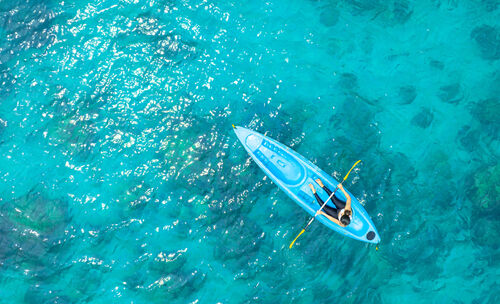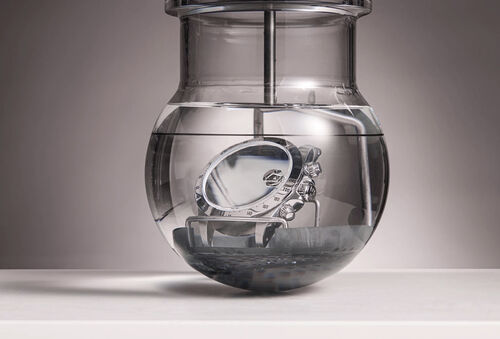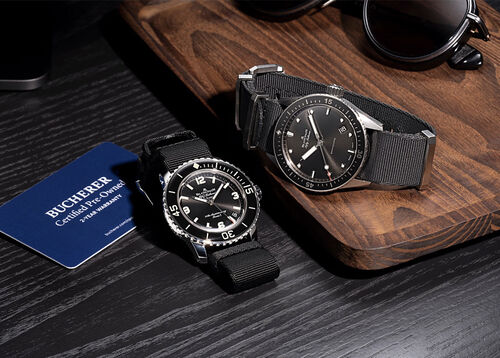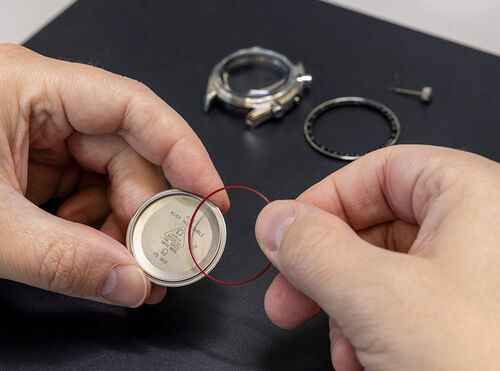Water Resistant Watches: Technology Meets Sports Performance
August 1, 2025
With their functional design and technical sophistication, water-resistant watches are popular with sports enthusiasts and watch lovers alike.

Water-resistant watches are technical masterpieces on your wrist. Design and craftsmanship must work together perfectly to protect a watch's delicate movement from external influences such as moisture and dust. The watchmaking industry continues to develop these watches with technical innovations, raising them to new levels of water resistance, durability, and precision. The pinnacle of water-resistant watches is the diving watch, coveted by amateur or professional divers, and general watch enthusiasts.
The case of a water-resistant watch must be impermeably sealed to protect the movement from moisture ingress. Some diving watches have other properties to ensure quality in various underwater conditions. For instance, some water-resistant watches are also suitable for the pool, lake, or sea, because they can withstand extreme pressure. These watches have specific features such as high water resistance, a rotating bezel for measuring the dive time, high legibility underwater, and robust construction.
The Oyster proved its water resistance on the wrist of 26-year-old Englishwoman Mercedes Gleitze, the first female swimmer to attempt to cross the English Channel in 1927. She abandoned the attempt after 10 hours due to adverse conditions, but the watch withstood the experiment.
With the Oyster model, Rolex became the driving force behind the development of the first diving watches. Thanks to Mercedes Gleitze’s tenacity, the Rolex watch and the swimmer became equally famous, symbolizing resilience and a pioneering spirit.
From the 1950s onwards, Rolex once again set a milestone in water-resistant watches by introducing a watch collection specially tailored to the needs of professional divers. The result was the Submariner, which had a water resistance of 100 meters. The water resistance of this iconic watch was further developed over time, so it was later certified as water-resistant to a depth of 300 meters.
The design of the Fifty Fathoms model was simple: a large, black-and-white dial and luminescent hands and indices ensure good readability even under water. With automatic winding and shielding against magnetic fields in the sea, Blancpain created the perfect diving watch.
The case of a water-resistant watch must be impermeably sealed to protect the movement from moisture ingress. Some diving watches have other properties to ensure quality in various underwater conditions. For instance, some water-resistant watches are also suitable for the pool, lake, or sea, because they can withstand extreme pressure. These watches have specific features such as high water resistance, a rotating bezel for measuring the dive time, high legibility underwater, and robust construction.
The History Of Waterproof Watches
The desire for greater durability grew as the watch slowly moved from the pocket to the wrist during the 19th century. Technical innovations and the discovery of robust materials made it possible to better protect delicate movements from moisture, sand, and dirt particles. With a focus on functionality, the first water-resistant wristwatchs launched at the beginning of the 20th century. The protective measures also benefit regular watch wearers, creating styles that aren't damaged by rain and splashing water when worn on the wrist in daily use.Rolex And The Invention Of The Diving Watch
In 1926, Rolex launched the first water-resistant wristwatch with the Oyster model. Hans Wilsdorf, the founder of Rolex, recognized the need for robust watches. The Oyster featured a hermetically sealed exterior (sealing against liquids, gases, and air) to prevent water from entering the movement. Rolex used a special screw technique for the crown and the patented Oyster case.The Oyster proved its water resistance on the wrist of 26-year-old Englishwoman Mercedes Gleitze, the first female swimmer to attempt to cross the English Channel in 1927. She abandoned the attempt after 10 hours due to adverse conditions, but the watch withstood the experiment.
With the Oyster model, Rolex became the driving force behind the development of the first diving watches. Thanks to Mercedes Gleitze’s tenacity, the Rolex watch and the swimmer became equally famous, symbolizing resilience and a pioneering spirit.
From the 1950s onwards, Rolex once again set a milestone in water-resistant watches by introducing a watch collection specially tailored to the needs of professional divers. The result was the Submariner, which had a water resistance of 100 meters. The water resistance of this iconic watch was further developed over time, so it was later certified as water-resistant to a depth of 300 meters.
The Blancpain Fifty Fathoms – The First Modern Diving Watch
In 1953, Swiss watch brand Blancpain presented the first Fifty Fathoms watch with a water resistance of 91 meters and a rotating bezel ring. Jean-Jaques Fiechter, the General Manager of Blancpain at the time and himself a passionate amateur diver, provided the impetus for developing a diving watch that could satisfy the requirements of a diving equipment instrument. Fiechter patented the invention of a water-resistant, double-sealed crown and a bezel with a locking mechanism. This mechanism prevented unintentional changes to the elapsed dive time. Blancpain recieved a third patent for the case back’s screw mechanism, making it possible to ensure a water-resistant seal.The design of the Fifty Fathoms model was simple: a large, black-and-white dial and luminescent hands and indices ensure good readability even under water. With automatic winding and shielding against magnetic fields in the sea, Blancpain created the perfect diving watch.
Patek Philippe “Nautilus”: Milestone in Water-Resistant Watches
The Nautilus sports watch was launched in 1976 by luxury watch manufacturer Patek Philippe. Developing a sporty and elegant-looking diving watch with a water resistance of 120 provided a significant challenge. The reference 3700/1A, with its 42-millimeter steel case, is now considered highly collectible as the original model of the Nautilus series. Visionary designer Gérals Genta created the octagonal case modeled on the shape of a porthole. This original aesthetic, which has become the unmistakable hallmark of the Nautilus, is still present in the current collections.Inspired by the Nautilus' shape and design, the Aquanaut, a sporty watch with the same water resistance, was launched in 1997. Its rubber strap is unaffected by salt water and UV radiation, quite an innovative feature in the 1990s.
How Does A Watch Become Water-Resistant?
A watch is considered water-resistant if the seals on the glass, crown, and case back can protect the delicate movement inside from moisture and, therefore, maintain precise timekeeping under a range of weather conditions. The seals of water-resistant watches regularly worn in water should be checked at least every two years. Daily use can affect the watch's water resistance, and creams, perfume, and soap can damage the seals and make them porous.A watch is made water-resistant by using various methods to prevent water from penetrating the case:
- - Seals: Rubber or silicone seals are installed in all screw threads and the case back.
- - Case construction: The case is constructed to ensure a tight seal with no openings or gaps.
- - Crown and push button: The crown and push buttons are often fitted with screw closures or seals to ensure they are tightly closed when not in use.
- - Sapphire crystal: High-quality diving watches often use sapphire crystal for the watch glass because it is extremely tough and scratch-resistant, offering good protection against water.
- - Testing and certification: After assembly, the watch is tested for water resistance, often using water pressure or special test devices. If the watch passes the tests, it is certified as water-resistant.
Cleaning A Water-Resistant Watch
Snorkeling, swimming, diving—whenever you wear your water-resistant watch in salt water, you should clean it thoroughly afterward. Saltwater can corrode high-quality materials such as gold or steel. Always clean your watch with water and mild soap after contact with salt water and dry it with a soft microfiber cloth to prevent damage.What Does The Description “Solar Diver” Mean In Water-Resistant Watches?
Solar Diver is a term often used to describe a special type of water-resistant watch that is both solar-powered and suitable for diving. These watches have solar panels on the dial that convert sunlight into electrical energy. This provides a reliable energy source, which is particularly convenient when the watch is used for dives with a constant and reliable power supply. The combination of solar technology and the features of a diving watch make the solar diver watches a popular choice for divers.Water Resistance Of Watches – How Is It Specified?
The water resistance indicates the depth to which you can safely use the watch without water ingress. It is important to note that the water resistance may decrease over time, especially if seals or the case are damaged. For this reason, water-resistant watches should be serviced and inspected regularly to ensure their protection is still intact.The water resistance of watches is specified in bar or meters.
- - Water-resistant watches with 3 bar or 5 bar are sufficiently protected against water in everyday wear. While you should take off a watch with 3 bar under running water, you can safely keep on a watch with 5 bar when bathing, showering or washing your hands.
- - Watches with 10 bar water resistance, corresponding to a hypothetical water column of 100 meters, can be worn for swimming and snorkeling.
- - A watch with a water resistance of 20 bar or a water column of 200 meters or more is suitable for diving.
- - For professional divers, watches must have a water resistance of 30, 50 or 100 bar or 300, 500 or 1,000 meters. These watches are often explicitly labeled as diving watches, which can be worn while scuba diving.
How Are Watches Tested For Water Resistance?
Various tests and measurement methods determine a watch's water resistance to ensure it can withstand the demands that may arise during diving or other water sports activities. These are some standard methods for measuring the water resistance of watches:- - Pressure test: One of the most common methods is the pressure test, in which the watch is placed in a special pressure chamber and pressurized with water. The watch is gradually submerged below the water surface while the pressure continuously increases. The watch is monitored to document whether and when water penetrates the case. The maximum depth at which the watch is still water resistant sets its water resistance rating.
- - Barometer test: The watch is placed in a water-filled chamber, where a barometer measures the pressure. Comparing the pressure inside the chamber with the atmospheric pressure allows the tester to determine the watch's water resistance.
- - Air pressure test: This method is similar to the pressure test, but the watch is placed in a pressurized airtight chamber to check whether air or moisture penetrates the case.
- - Visual inspection: After the pressure tests, the watch is visually inspected for signs of moisture inside the case or damage to the seals.

The results of these tests give the watch a corresponding water resistance rating, which indicates the depth to which a water-resistant watch can be worn without water penetrating the case.
A water-resistant watch is more than an accessory; it is a statement of sophistication and durability. These timepieces seamlessly blend exquisite craftsmanship with advanced technology, offering peace of mind for those who appreciate both elegance and adventure.
SHOP CERTIFIED PRE-OWNED SHOP NEW
A water-resistant watch is more than an accessory; it is a statement of sophistication and durability. These timepieces seamlessly blend exquisite craftsmanship with advanced technology, offering peace of mind for those who appreciate both elegance and adventure.
SHOP CERTIFIED PRE-OWNED SHOP NEW




